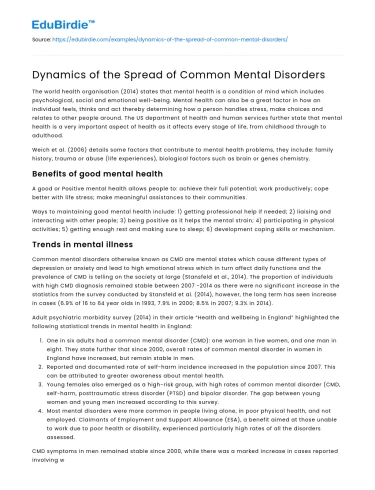The world health organisation (2014) states that mental health is a condition of mind which includes psychological, social and emotional well-being. Mental health can also be a great factor in how an individual feels, thinks and act thereby determining how a person handles stress, make choices and relates to other people around. The US department of health and human services further state that mental health is a very important aspect of health as it affects every stage of life, from childhood through to adulthood.
Weich et al. (2006) details some factors that contribute to mental health problems, they include: family history, trauma or abuse (life experiences), biological factors such as brain or genes chemistry.
Save your time!
We can take care of your essay
- Proper editing and formatting
- Free revision, title page, and bibliography
- Flexible prices and money-back guarantee
Benefits of good mental health
A good or Positive mental health allows people to: achieve their full potential; work productively; cope better with life stress; make meaningful assistances to their communities.
Ways to maintaining good mental health include: 1) getting professional help if needed; 2) liaising and interacting with other people; 3) being positive as it helps the mental strain; 4) participating in physical activities; 5) getting enough rest and making sure to sleep; 6) development coping skills or mechanism.
Trends in mental illness
Common mental disorders otherwise known as CMD are mental states which cause different types of depression or anxiety and lead to high emotional stress which in turn affect daily functions and the prevalence of CMD is telling on the society at large (Stansfeld et al., 2014). The proportion of individuals with high CMD diagnosis remained stable between 2007 -2014 as there were no significant increase in the statistics from the survey conducted by Stansfeld et al. (2014), however, the long term has seen increase in cases (6.9% of 16 to 64 year olds in 1993, 7.9% in 2000; 8.5% in 2007; 9.3% in 2014).
Adult psychiatric morbidity survey (2014) in their article “Health and wellbeing in England” highlighted the following statistical trends in mental health in England:
- One in six adults had a common mental disorder (CMD): one woman in five women, and one man in eight. They state further that since 2000, overall rates of common mental disorder in women in England have increased, but remain stable in men.
- Reported and documented rate of self-harm incidence increased in the population since 2007. This can be attributed to greater awareness about mental health.
- Young females also emerged as a high-risk group, with high rates of common mental disorder (CMD, self-harm, posttraumatic stress disorder (PTSD) and bipolar disorder. The gap between young women and young men increased according to this survey.
- Most mental disorders were more common in people living alone, in poor physical health, and not employed. Claimants of Employment and Support Allowance (ESA), a benefit aimed at those unable to work due to poor health or disability, experienced particularly high rates of all the disorders assessed.
CMD symptoms in men remained stable since 2000, while there was a marked increase in cases reported involving women. Reports of self-harm amongst men and women did increase from 2007-2014. Adult psychiatric morbidity survey (2014), Survey from Department of Health (2014) postulated that in 2014 one in five young adult women had history of self–harming. The department of health further states that most of the young people who reported self-harm did not seek professional help thereafter. The department carries on further stating that in the long term this behaviour is detrimental as it can turn to a coping mechanism for people dealing with some form of CMD and this may lead to higher suicide rate in the population.
Since 2007 increase in CMD has been prevalent amongst midlife men and women (55) and high in young women aged 16-24 (Stansfeld et al., 2014). The gap has increased overtime in the rate of symptoms between young me and women and the statistics from the survey conducted by Stansfeld et al. (2014) demonstrate this with the statistics below:
- In 1993, 16 to 24 year old women (19.2%) were twice as likely as 16 to 24 year old men (8.4%) to have symptoms of CMD.
- In 2014, CMD symptoms were more common in women of that age (26.0%) than men (9.1%). CMDs were more predominant in certain groups of the general population which included Black women, adults under the age of 60 who lived by themselves, women who lived in big households, individuals not in employment.
Conclusion
According to Zivin et al. (2015), the reduction of Common mental disorders like anxiety and depression has become a major public challenge for the NHS over the years. CMD are linked and associated with social and physical problems and in most cases can end or result in social and occupational malfunction and physical impairment. CMD are a serious and important source of distress to people with symptoms and even those around them are affected which in turn affects the society at large. In most cases anxiety and depression remain undiagnosed and treatment is not received by individuals suffering from it.
Zivin et al. (2015) concludes that if mental health is left, unattended or untreated, CMDs will lead to long term social, occupational and physical disability and can lead to premature mortality.






 Stuck on your essay?
Stuck on your essay?

